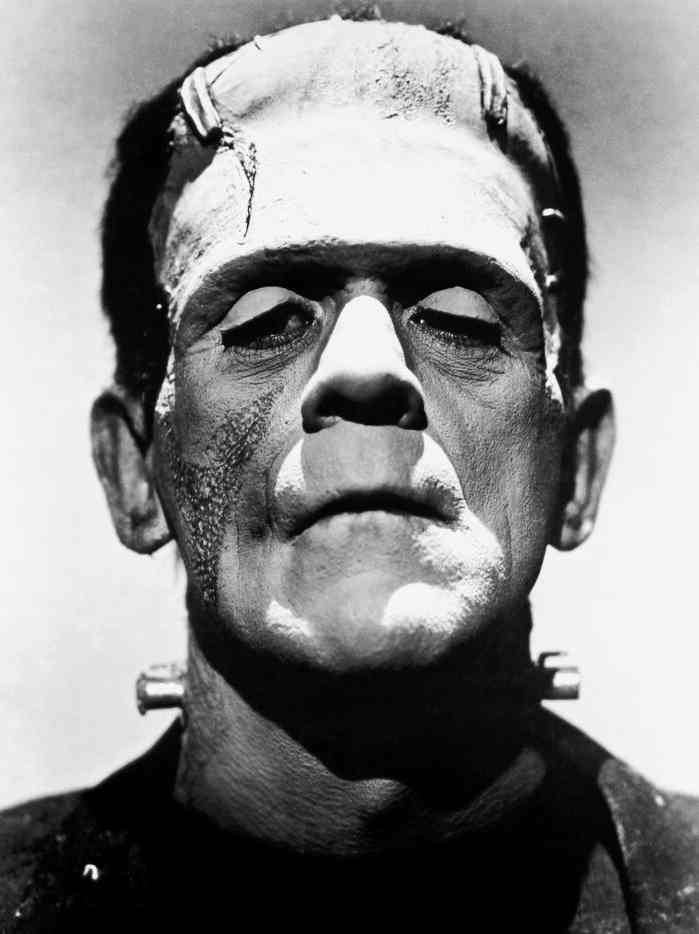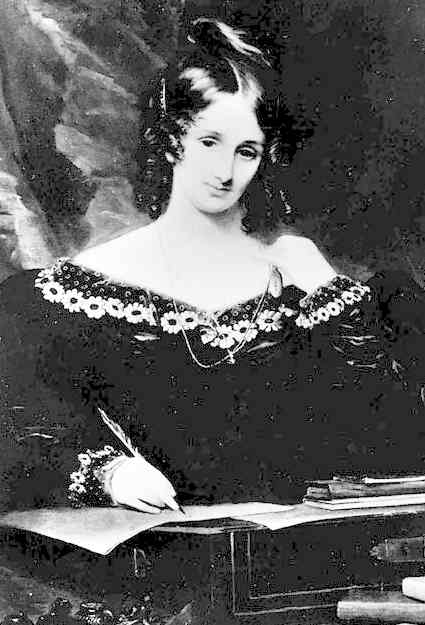|
FRANKENSTEIN
|
||||||||||||||||||||||||||||||||
|
HOME | BIOLOGY | FILMS | GEOGRAPHY | HISTORY | INDEX | INVESTORS | MUSIC | SOLAR BOATS | SPORT |
||||||||||||||||||||||||||||||||
|
Frankenstein; or, The Modern Prometheus is an 1818 novel by Mary Shelley, first published anonymously in London, but more often known by the revised third edition of 1831 under her own name. It is a novel infused with some elements of the Gothic novel and the Romantic movement. It was also a warning against the "over-reaching" of modern man and the Industrial Revolution, alluded to in the novel's subtitle, The Modern Prometheus. The story has had an influence across literature and popular culture and spawned a complete genre of horror stories and films. Many distinguished authors, such as Brian Aldiss, consider this the very first science fiction novel.
Boris Karloff as the Frankenstein Monster
Plot summary
The novel opens with Captain Walton on his ship sailing north of the Arctic Circle. Walton's ship becomes ice-bound, and as he contemplates his isolation and paralysis, he spots a figure traveling across the ice on a dog sled. This is Victor Frankenstein's creature. Soon after he sees the ill Victor Frankenstein himself, and invites him onto his boat. The narrative of Walton is a frame narrative that allows for the story of Victor to be related. At the same time, Walton's predicament is symbolically appropriate for Victor's tale of displaced passion and brutalism.
Victor takes over telling the story at this point. Curious and intelligent from a young age, he learns from the works of the masters of Medieval alchemy, reading such authors as Albertus Magnus, Cornelius Agrippa and Paracelsus and shunning modern Enlightenment teachings of natural science (see also Romanticism and the Middle Ages). He leaves his beloved family in Geneva, Switzerland to study in Ingolstadt, Bavaria, Germany, where he is first introduced to modern science. In a moment of inspiration, combining his new-found knowledge of natural science with the alchemic ideas of his old masters, Victor perceives the means by which inanimate matter can be imbued with life. He sets about constructing a man—perhaps intended as a companion—using means that Shelley refers to only vaguely. The main idea seems to be that Victor built a complete body from various organic parts, then simulated the functions of the human system in it. In the novel it is stated (chapter 4, volume 1) that he uses bones from charnel houses (repositories for the bones or bodies of the dead), and
Subsequent visual interpretations of the story have included the creation of Frankenstein's monster through alchemy, by the piecing together of corpses, or a combination of the two. In films, the body is often given the "spark of life" in the form of a channeled lightning bolt, conducted from a lightning rod during a stormy night.
Victor intended the creature to be beautiful, but when it awakens he is disgusted. It has yellow, watery eyes, translucent skin, and is of an abominable size. Victor finds this revolting and runs out of the room in terror. That night he wakes up with the creature at his bedside facing him with an outstretched arm, and flees again, whereupon the creature disappears. Shock and overwork cause Victor to take ill for several months. After recovering, in about a year's time, he receives a letter from home informing him of the murder of his youngest brother William. He departs for Switzerland at once.
Near Geneva, Victor catches a glimpse of the creature in a thunderstorm among the rocky boulders of the mountains, and is convinced that it killed William. Upon arriving home he finds Justine, the family's beloved maid, framed for the murder. To Victor's surprise, Justine makes a false confession because her minister threatens her with excommunication. Despite Victor's feelings of overwhelming guilt, he does not tell anyone about his horrid creation and Justine is convicted and executed. To recover from the ordeal, Victor goes hiking into the mountains where he encounters his "cursed creation" again, this time on the Mer de Glace, a glacier above Chamonix.
The creature converses with Victor and tells him his story, speaking in strikingly eloquent and detailed language. He describes his feelings first of confusion, then rejection and hate. He explains how he learned to talk by studying a poor peasant family through a chink in the wall. He performs in secret many kind deeds for this family, but in the end, they drive him away when they see his appearance. He gets the same response from any human who sees him. The creature confesses that it was indeed he who killed William and framed Justine, and that he did so out of revenge. But now, the creature only wants companionship. He begs Victor to create a synthetic woman (counterpart to the synthetic man), with whom the creature can live, sequestered from all humanity but happy with his mate.
At first, Victor agrees, but later, he tears up the half-made companion in disgust and madness. In retribution, the creature kills Clerval, Victor's best friend, and later, on Victor's wedding night, his wife Elizabeth. Victor now becomes the hunter: he pursues the creature into the Arctic ice, though in vain. Near exhaustion, he is stranded when an iceberg breaks away, carrying him out into the ocean. Before death takes him, Captain Walton's ship arrives and he is rescued.
Walton assumes the narration again, describing a temporary recovery in Victor's health, allowing him to relate his extraordinary story. However, Victor's health soon fails, and he dies. Unable to convince his shipmates to continue north and bereft of the charismatic Frankenstein, Walton is forced to turn back towards England under the threat of mutiny. Finally, the creature boards the ship and finds Victor dead, and greatly laments what he has done to his maker. He vows to commit suicide. He leaves the ship by leaping through the cabin window onto the ice, and is never seen again.
Mary Shelley, author Frankenstein horror story
Genesis
During the snowy summer of 1816, the "Year Without A Summer," the world was locked in a long cold volcanic winter caused by the eruption of Tambora in 1815. In this terrible year, the then Mary Wollstonecraft Godwin, age 19, and her husband-to-be Percy Bysshe Shelley, visited Lord Byron at the Villa Diodati by Lake Geneva in Switzerland. The weather was consistently too cold and dreary that summer to enjoy the outdoor vacation activities they had planned, so after reading Fantasmagoriana, an anthology of German ghost stories, Byron challenged the Shelleys and his personal physician John William Polidori to each compose a story of their own, the contest being won by whoever wrote the scariest tale. Mary conceived an idea after she fell into a waking dream or nightmare during which she saw "the pale student of unhallowed arts kneeling beside the thing he had put together." This was the germ of Frankenstein. Byron managed to write just a fragment based on the vampire legends he heard while travelling the Balkans, and from this Polidori created The Vampyre (1819), the progenitor of the romantic vampire literary genre. Thus, the Frankenstein and vampire themes were created from that single circumstance.
Publication
Mary Shelley completed her writing in May 1817, and Frankenstein, or The Modern Prometheus was first published on 1 January 1818 by the small London publishing house of Lackington, Hughes, Harding, Mavor & Jones. It was issued anonymously, with a preface written for Mary by Percy Bysshe Shelley and with a dedication to philosopher William Godwin, her father. It was published in an edition of just 500 copies in three volumes, the standard "triple-decker" format for 19th century first editions. The novel had been previously rejected by Percy Bysshe Shelley's publisher Charles Ollier and by Byron's publisher John Murray.
Critical reception of the book was mostly unfavourable, compounded by confused speculation as to the identity of the author, which was not well disguised. Walter Scott wrote that "Upon the whole, the work impresses us with a high idea of the author's original genius and happy power of expression", but most reviewers thought it "a tissue of horrible and disgusting absurdity" (Quarterly Review).
Despite the reviews, Frankenstein achieved an almost immediate popular success. It became widely known especially through melodramatic theatrical adaptations – Mary Shelley saw a production of Presumption; or The Fate of Frankenstein, a play by Richard Brinsley Peake, in 1823. A French translation appeared as early as 1821 (Frankenstein: ou le Prométhée Moderne, translated by Jules Saladin).
The second edition of Frankenstein was published on 11 August 1823 in two volumes (by G. and W. B. Whittaker), and this time credited Mary Shelley as the author.
On 31 October 1831, the first "popular" edition in one volume appeared, published by Henry Colburn & Richard Bentley. This edition was quite heavily revised by Mary Shelley, and included a new, longer preface by her, presenting a somewhat embellished version of the genesis of the story. This edition tends to be the one most widely read now, although editions containing the original 1818 text are still being published. In fact, many scholars prefer the 1818 edition. They argue that it preserves the spirit of Shelley's original publication (see Anne K. Mellor's "Choosing a Text of Frankenstein to Teach" in the W. W. Norton Critical edition).
The revised edition was changed in several significant ways: any indication that Frankenstein's monster was created by vice was removed, and the text details a benevolent creator who creates the monster merely for the purposes of science. Suggestions of an incestuous relationship between Victor and Elizabeth are also removed, by making Elizabeth an adopted child of the Frankensteins.
LINKS and REFERENCE
Editions
Resources
|
||||||||||||||||||||||||||||||||
|
This
website
is Copyright © 1999 & 2013. The bird |
||||||||||||||||||||||||||||||||
|
AUTOMOTIVE | BLUEBIRD | ELECTRIC CARS | FORMULA E | SOLAR CARS |
||||||||||||||||||||||||||||||||

